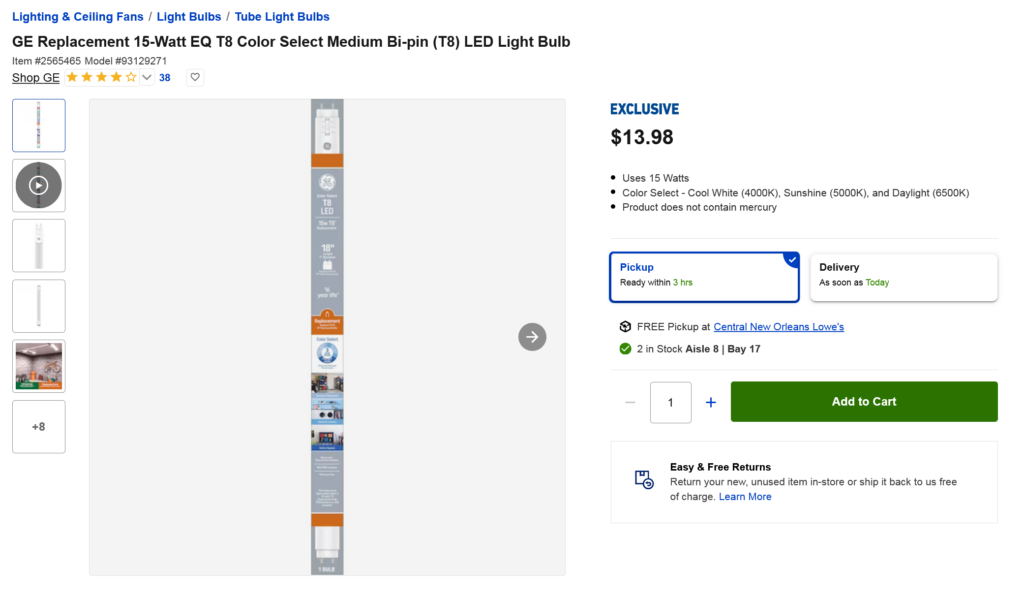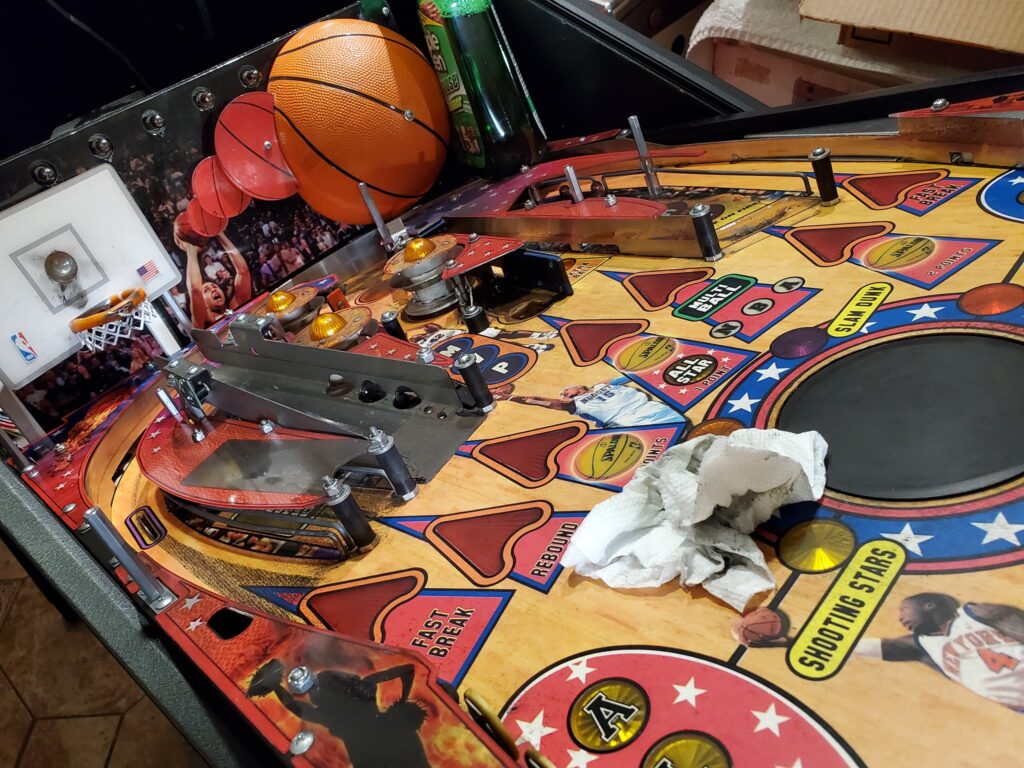I’ve encountered an odd problem with this Stern Walking Dead pinball game. The sound completely went out. But there is not a dedicated sound board. So what do you do? It’s a lot scarier than one would think…. This is part one describing what’s going on and what I’m doing about it…
Category Archives: Stern
A great upgrade for lighting arcades & pinballs
As work continues repairing this Frogger video arcade, I was planning to do a video on retrofitting the 18″ T8 fluorescent bulb that lights the marquee with an LED (and removing the ballast wiring) which is also used on some pinball machines from the 2000s, I discovered an even better lighting option you can probably find at your local Lowes. Check it out.
Here is the bulb in question:

Diagnosing Coil Problems (and more) On a Simpson’s Pinball Party
An odd assortment of things are wrong on this TSPP pinball machine. Are they related? Let’s look into what’s wrong and where we should look to fix things?
This has now turned into a multi-part series where I also discover some other issues:
So here’s the take-away from the first 5 parts of this series.
Everything was basically inter-related (except I believe the slingshot and pop bumper coils were separate failures). The trouble with the ball trough opto led to the failure of the shooter lane coil. When the ball trough opto started failing, it signaled false switch closings, tricking the game into thinking balls were moving through the trough and causing the VUK to try to clear a problem, which caused multiple balls to go into the shooter lane. This happened faster than the auto-plunger could handle and once X number of balls went in there, the plunger could not clear them, and eventually the MPU sent too many “fire-the-coil” signals and blew the driver transistor — interesting that it blew the driver transistor before it melted the coil — I suspect either (or both) can happen in this circumstance.
What’s interesting about this, is that this problem could be compensated for by software. It’s also possible the other coil failures are the result of a similar characteristic: Not having a certain timeout or duty-cycle enforced on coils. Meaning… the software could check to make sure that if a coil is firing too much (say x amount of times in y time), that it knows there’s some kind or problem and then put the game into some sort of error state rather than blow the coil or the drivers. I know in some later games this happens… when errors are encountered, the game just stops trying to fire coils rather than blow them.
This obviously isn’t the case in some of these 2000-era Stern games. I’ve noticed this on several titles including WPT and NBA as well.
Unfortunately, there’s not likely to be a software fix available, so what is important is to keep an eye on game behavior and try to catch switch malfunctions before they blow things. Had I been told about the shooter lane situation earlier, I could have fixed the opto before it blew the driver transistor on the SDB.
First Impressions: James Bond pinball – do we have some problems with this layout?
NOTE: This is just an initial “first impression” and I reserve the right to change my mind – the code is very early and obviously unfinished.
I’ve had a chance to put a dozen or so games onto the new James Bond in both the pro and the premium and I thought I might jot down my first impressions because that is also what casual players are first-time players might experience. so here are my thoughts.
Also, after I did this video, I probably put another 40+ games on both the pro and the premium versions. I still think my initial first impression holds… HOWEVER, I seem to recall I had some similar concerns with Gomez’ design on Deadpool (specifically the cross-playfield katana shot that I thought was going to be very difficult to achieve and frustrate players — however, that shot ended up NOT being a critical shot in the game’s progress so even though it was difficult, it wasn’t required). This may be the same situation with the far left ramp shot (that feeds Jet Pack Multiball) but it also seems that this shot may be needed to qualify some of the modes — not sure, but if that’s the case, it becomes more difficult. I do know that Gomez can turn around things like this with tweaks to the ruleset, but I continue to feel, the feed from the plunger/pops to the slings creates a high degree of drains without getting flippers on the ball. This will be a game to watch to see if they can address this via the ruleset… I just don’t know.
In summary, here are some of my concerns:
- Upper skill shots are very predictable and consistent
- Pop bumpers are like Avatar… the ball can get stuck up there longer than is probably ideal
- Pop bumpers feed ball to the outlane or the slings – meaning like Avatar and Ghostbusters, you can lose the ball without ever getting a flipper on it
- To compound the previous issue, the lower left kickout will throw the ball back into the pops regularly
- The left ramp shot is very difficult to make – not only is it very tight, but it requires maximum velocity and if you miss it can go SDTM or to the slings
- It also appears that the left ramp shot may be required to qualify modes – a hard shot that will frustrate players
- The lower left kickout area just looks and feels “unfinished” from a design standpoint – it covers a large area and the ball often falls into it and then kicks up to the pops — it just seems like an odd playfield feature that might have been a cheap compromise instead of something more expensive like a subway entrance or exit
- The upper left flipper has a number of shots to make, but they’re not easy and those right ramp shots appear to be necessary for various modes
- The right outhole shot feels even more difficult than the one on Godzilla (and Godzilla has a pop bumper to help you hit it) and it appears to be very important in starting many modes, so a lot of key shots are particularly difficult
- The center loop shot appears to be easy but it’s much more difficult to hit due to the switch that registers the hit being at the top of the orbit. It has a very narrow feed and not a very wide opening, and it’s slightly angled. This is the lock shot for Bird multiball – the most obvious and easiest multi-ball and it’s frustratingly difficult — and if you miss, it can go SDTM
It seems obvious the software has a LONG way to go, and can fix some of these problems, but I’m concerned it can’t fix others. We’ll have to see.
First Impressions: Stern Godzilla. Which is the better game? Pro or Premium?
We’ve been having a lot of fun with this game lately – I’m still not qualified to do a “pinball showcase” because the ruleset is so complicated (and partially unfinished) that I’m not ready to do that, but I can comment on what I think of the game and which version is the one you might want depending upon your priorities?
Working on a Jurassic Park pinball on location
After having this game on location for awhile, I thought I might report on what types of wear and tear and damage I’m running into, and what was wrong with the game. I think we’ve found a few “weak links” relating to parts that probably should last a little longer. Check it out:
2008 Stern “NBA” – First Look and Restoration Series
This is a very cool game that is surprisingly rare. A 2008 Stern “NBA”. Rumor has it the game had a very low production and was mainly made for the Chinese market.
I had a chance to get one of these games that had been stuffed in the back of an operators office for many years. It needed quite a bit of work. Here is the whole video series from first look, to the repairs, to the showcase of gameplay:

